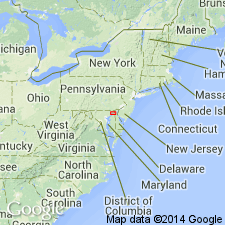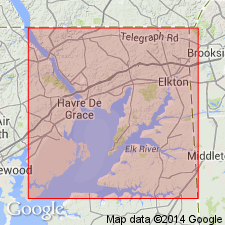
- Usage in publication:
-
- Gilpins Falls Member*
- Modifications:
-
- Named
- Dominant lithology:
-
- Basalt
- AAPG geologic province:
-
- Piedmont-Blue Ridge province
Summary:
Name Gilpins Falls Member of James Run Formation proposed in this report for metamorphosed basaltic rocks along Northeast Creek in Cecil Co., northeastern MD. Includes metagraywacke, diamictite, and pelitic schist. Distinctive pillow basalt. Interbedded with Wissahickon Formation. Assigned to Glenarm Series. Age is Cambrian.
Source: GNU records (USGS DDS-6; Reston GNULEX).

- Usage in publication:
-
- Gilpins Falls Member*
- Modifications:
-
- Age modified
- Areal extent
- AAPG geologic province:
-
- Piedmont-Blue Ridge province
Summary:
Age of Gilpins Falls changed from Late Cambrian to early Paleozoic. Member extends into western DE. Overlies Frenchtown Member (revised); underlies Big Elk Creek Member (new). All of James Run Formation of Glenarm Group.
Source: GNU records (USGS DDS-6; Reston GNULEX).
For more information, please contact Nancy Stamm, Geologic Names Committee Secretary.
Asterisk (*) indicates published by U.S. Geological Survey authors.
"No current usage" (†) implies that a name has been abandoned or has fallen into disuse. Former usage and, if known, replacement name given in parentheses ( ).
Slash (/) indicates name conflicts with nomenclatural guidelines (CSN, 1933; ACSN, 1961, 1970; NACSN, 1983, 2005, 2021). May be explained within brackets ([ ]).

